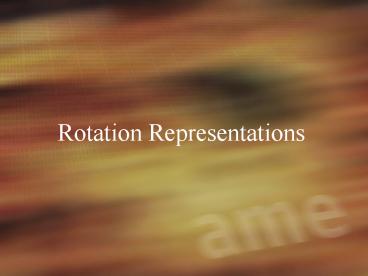Rotation Representations - PowerPoint PPT Presentation
1 / 10
Title:
Rotation Representations
Description:
true of all parameterizations other than trivial SO(3) Rotation ... Yaw-Pitch-Roll ... For Yaw-Pitch-Roll Convention. Rotation Axis Angle. Euler's ... – PowerPoint PPT presentation
Number of Views:135
Avg rating:3.0/5.0
Title: Rotation Representations
1
Rotation Representations
2
Rotations Differ from Translations
- Rotations are non-Euclidean
- like travelling on a globe vs. a grid
- Rotations are not commutative
- x-rotate, y-rotate is not equal y-rotate,
x-rotate etc. - Rotations are non-linear
- true of all parameterizations other than trivial
SO(3)
3
Rotation Parameterization
- Represent rotation space in Euclidean R3
- e.g. Euler angles, exponential map
- Pros
- three parameters for three DOFs
- Cons
- singularities, potentially poor interpolation
4
Rotation Parameterization
- non-Euclidean space
- e.g. unit quaternions (S3)
- Pros
- singularity free
- Cons
- must take extra measures to stay in legal
sub-space - four parameters required for three DOFs
5
Euler angles (f,?,?)
- An Euler angle is a rotation about a single
Cartesian axis - Create multi-DOF rotations by concatenating
Eulers - R R? R? Rf
- 3 DOFs can be obtained by
concatenating
Euler-X
Euler-Y
Euler-Z
6
X-Convention
- Most commonly used
- The rotation given by Euler angles (f,?,?), where
the first rotation is by an angle f about the
z-axis, the second is by an angle ? about the
x-axis, and the third is by an angle ? about the
z-axis (again). - R R? R? Rf
7
Yaw-Pitch-Roll Convention
8
Singularities
- More than one sets of parameters can create the
same rotation matrix. - Gimbal lock - two or more axes align, results in
loss of rotational DOFs - For Yaw-Pitch-Roll Convention
9
Rotation Axis Angle
- Eulers Rotation Theorem
- all rotations can be expressed as axis/angle
10
Quaternions
- Traditional solution Use unit quaternions to
represent rotations - S3 has same topology as rotation space (a
sphere), so no singularities - A member of unit sphere in R4
- q(qx,qy,qz,qw)
- a rotation about unit axis v































